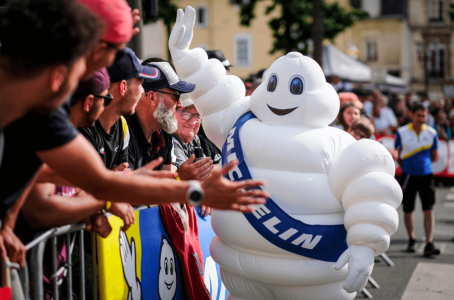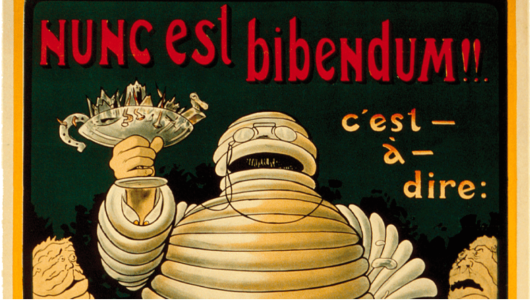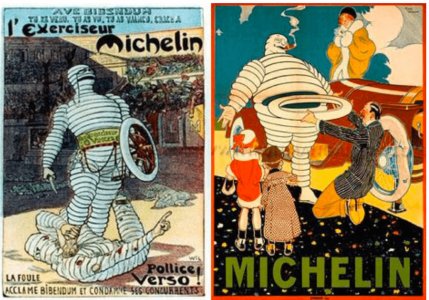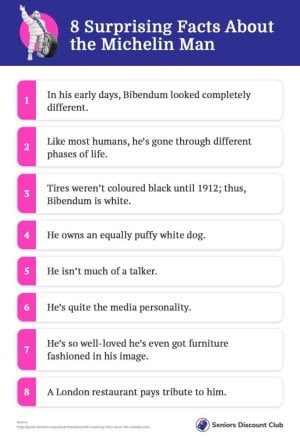From Martini-Drinking Mummy to Pop Culture Icon: The Fascinating Evolution of the Michelin Man!
- Replies 7
Get ready to delve into the fascinating history of one of the most beloved mascots of all time - the Michelin Man, also known as 'Bib'!
This iconic white, rotund character has been a staple of the French tire company's branding for years, but do you know the incredible story behind his creation?
From his humble beginnings to his rise to fame, we're here to take you on a thrilling journey through the evolution of this lovable character. Discover the mysteries surrounding his origins and learn about the many changes and adaptations he's undergone.

Imagine this - it's the year 1894, and you find yourself at the Lyon Universal Exhibition in France. You're wandering through the exhibits when suddenly, you come across a pile of tires that catches your eye.
For André and Édouard Michelin, the founders of the Michelin company, this was no ordinary pile of tires. As they gazed upon it, Édouard remarked to his brother, 'Look, with arms, it would make a man.'
Little did they know that this passing comment would give birth to one of the most iconic mascots in history - the Michelin Man! From that moment on, the brothers began to develop their vision of a tire-man hybrid, and soon the first version of the Michelin Man came to life.
Believe it or not, the early iterations of the Michelin Man were far from the friendly and lovable character we recognise today. In fact, the first version of the Michelin Man looked more like a chubby, somewhat intimidating Egyptian mummy!

In those early days, ‘Bib’ was often depicted holding a martini glass filled not with a refreshing cocktail but with nails and glass shards. While this may sound strange to us now, it was actually meant to convey an important message to drivers - that Michelin tires were tough, durable, and virtually puncture-proof.
Though this version of Bib may seem grim, it was a powerful representation of the Michelin brand's values and commitment to quality. As we'll soon see, however, the Michelin Man was destined for a transformation that would change his appearance and make him the iconic character we all know and love today.
Early advertisements featured Bib alongside the Latin phrase 'Nunc est Bibendum', which translates to 'now is the time to drink'. This catchy slogan became the Michelin Man's signature phrase and helped establish him as a recognisable figure.
As the years went by, Bib's persona continued to evolve, and he was depicted in a wide range of scenarios. From gladiator to ballroom dancer, kickboxer to a ladies' man, Bib was a character that could do it all.
He embraced the high life, often seen with a cigar and a glass of beer in hand - a nod to the upper class, who were the only ones able to afford cars in those days...

As the 1920s arrived, a noticeable shift occurred in the way the Michelin Man was portrayed. The brand began to focus on family-friendly messaging, and with it came a transformation in Bib's appearance. Out went the cigars and beers, replaced by frisbees, bicycles, and a more athletic physique - a far cry from his original 'dad-bod'!
This was just the first of many transformations for Bib, as he continued to adapt to suit the changing cultural zeitgeist. Despite these changes, however, Bib remained a beloved symbol of the Michelin brand, a constant reminder of the company's commitment to innovation and quality.
Have you ever wondered why Bib is composed of white-coloured tires rather than the standard black? It's a common question that has intrigued many Michelin enthusiasts over the years. The answer, it turns out, is rather simple.
Tires didn't actually take on their recognisable black hue until 1912, a full 18 years after Bib's creation. Prior to that, tires were a grey-white or beige colour, according to Michelin's own blog.
So, the white colour that we associate with Bib today is actually a nod to the earliest days of tire manufacturing.
While the Michelin Man may not be much of a talker, he has certainly made his mark on popular culture in a variety of ways. For example, he authored a travel column in the company's Italian magazine in 1907, expressing his appreciation for Renaissance art.
This unexpected foray into travel writing gave Bib an even wider audience and cemented his status as a beloved cultural icon.
In addition to his travel writing exploits, Bib has also made appearances in iconic French comic books such as Asterix and even starred in a 16-minute short film, Logorama, which won an Oscar. It's clear that Bib's appeal extends far beyond the tire industry and speaks to a larger cultural fascination with his unique character and backstory.
Perhaps one of Bib's greatest honours came in the year 2000 when a panel of 22 designers selected him as the best logo ever created. This impressive accolade speaks to the enduring appeal of Bib's distinctive design and the impact that he has had on the world of branding and marketing.
But Bib's cultural impact extends far beyond the world of design and marketing. He even has a London restaurant named after him - the Bibendum Restaurant and Oyster Bar.
Situated in the Fulham neighbourhood's Michelin House, which was previously the company's London headquarters up until 1985, the restaurant is a testament to Bib's lasting legacy and cultural impact.

The Michelin Man, or Bibendum, has had an illustrious career spanning over a century. What started out as a simple observation about a stack of tires has evolved into a beloved cultural icon that has captured the hearts and minds of people all over the world.
Bib's appeal goes beyond his quirky backstory and unique character design. His enduring popularity speaks to a larger cultural fascination with branding and marketing and the power that these industries have to shape our perceptions and preferences.
So what is it about Bib that makes him such a beloved cultural icon? Is it his charming design, his quirky backstory, or something else entirely? And what does his lasting legacy tell us about the power of branding and marketing in shaping our cultural landscape?
These questions will likely continue to be debated and discussed for years as Bib and his tire-formed body remain a fixture of the cultural imagination. Whatever the answer, one thing is clear - the Michelin Man has certainly earned his place in the pantheon of cultural icons and will likely continue to do so for many years to come.
Credit: MICHELIN.
We hope you've enjoyed diving into the intriguing history of the Michelin Man with us! We certainly had a blast sharing all the juicy details of Bib's evolution over the years. But we also want to hear from you!
Do you have any thoughts on Bib's fascinating backstory? Did you learn something new and interesting about this beloved mascot? And perhaps most importantly, do you know of any other iconic logos or mascots with a similarly rich history behind them?
Don't be shy - let us know your thoughts in the comments!
This iconic white, rotund character has been a staple of the French tire company's branding for years, but do you know the incredible story behind his creation?
From his humble beginnings to his rise to fame, we're here to take you on a thrilling journey through the evolution of this lovable character. Discover the mysteries surrounding his origins and learn about the many changes and adaptations he's undergone.

The Michelin Man has become a part of pop culture, appearing in various advertisements and comic books and even winning an award for one of the best logos ever created. Credit: Facebook/Michelin.
Imagine this - it's the year 1894, and you find yourself at the Lyon Universal Exhibition in France. You're wandering through the exhibits when suddenly, you come across a pile of tires that catches your eye.
For André and Édouard Michelin, the founders of the Michelin company, this was no ordinary pile of tires. As they gazed upon it, Édouard remarked to his brother, 'Look, with arms, it would make a man.'
Little did they know that this passing comment would give birth to one of the most iconic mascots in history - the Michelin Man! From that moment on, the brothers began to develop their vision of a tire-man hybrid, and soon the first version of the Michelin Man came to life.
Believe it or not, the early iterations of the Michelin Man were far from the friendly and lovable character we recognise today. In fact, the first version of the Michelin Man looked more like a chubby, somewhat intimidating Egyptian mummy!

Rather than the warm, smiley mascot of today, the Michelin Man's original design was more akin to a fat Egyptian mummy. Credit: MICHELIN Guide.
In those early days, ‘Bib’ was often depicted holding a martini glass filled not with a refreshing cocktail but with nails and glass shards. While this may sound strange to us now, it was actually meant to convey an important message to drivers - that Michelin tires were tough, durable, and virtually puncture-proof.
Though this version of Bib may seem grim, it was a powerful representation of the Michelin brand's values and commitment to quality. As we'll soon see, however, the Michelin Man was destined for a transformation that would change his appearance and make him the iconic character we all know and love today.
Early advertisements featured Bib alongside the Latin phrase 'Nunc est Bibendum', which translates to 'now is the time to drink'. This catchy slogan became the Michelin Man's signature phrase and helped establish him as a recognisable figure.
As the years went by, Bib's persona continued to evolve, and he was depicted in a wide range of scenarios. From gladiator to ballroom dancer, kickboxer to a ladies' man, Bib was a character that could do it all.
He embraced the high life, often seen with a cigar and a glass of beer in hand - a nod to the upper class, who were the only ones able to afford cars in those days...

As society drifted away from the idea of a man always being seen with a cigar or a glass of beer in hand, he was eventually given a more family-friendly look. Credit: MICHELIN Guide.
As the 1920s arrived, a noticeable shift occurred in the way the Michelin Man was portrayed. The brand began to focus on family-friendly messaging, and with it came a transformation in Bib's appearance. Out went the cigars and beers, replaced by frisbees, bicycles, and a more athletic physique - a far cry from his original 'dad-bod'!
This was just the first of many transformations for Bib, as he continued to adapt to suit the changing cultural zeitgeist. Despite these changes, however, Bib remained a beloved symbol of the Michelin brand, a constant reminder of the company's commitment to innovation and quality.
Have you ever wondered why Bib is composed of white-coloured tires rather than the standard black? It's a common question that has intrigued many Michelin enthusiasts over the years. The answer, it turns out, is rather simple.
Tires didn't actually take on their recognisable black hue until 1912, a full 18 years after Bib's creation. Prior to that, tires were a grey-white or beige colour, according to Michelin's own blog.
So, the white colour that we associate with Bib today is actually a nod to the earliest days of tire manufacturing.
While the Michelin Man may not be much of a talker, he has certainly made his mark on popular culture in a variety of ways. For example, he authored a travel column in the company's Italian magazine in 1907, expressing his appreciation for Renaissance art.
This unexpected foray into travel writing gave Bib an even wider audience and cemented his status as a beloved cultural icon.
In addition to his travel writing exploits, Bib has also made appearances in iconic French comic books such as Asterix and even starred in a 16-minute short film, Logorama, which won an Oscar. It's clear that Bib's appeal extends far beyond the tire industry and speaks to a larger cultural fascination with his unique character and backstory.
Perhaps one of Bib's greatest honours came in the year 2000 when a panel of 22 designers selected him as the best logo ever created. This impressive accolade speaks to the enduring appeal of Bib's distinctive design and the impact that he has had on the world of branding and marketing.
But Bib's cultural impact extends far beyond the world of design and marketing. He even has a London restaurant named after him - the Bibendum Restaurant and Oyster Bar.
Situated in the Fulham neighbourhood's Michelin House, which was previously the company's London headquarters up until 1985, the restaurant is a testament to Bib's lasting legacy and cultural impact.
Key Takeaways
- The Michelin Man, also known as Bibendum or Bib, is a beloved cultural icon and one of the most recognisable brand mascots in the world.
- Created in 1894 by Michelin founders André and Édouard Michelin, Bib has evolved throughout the years, taking on a variety of personas and cultural references.
- Despite his non-verbal nature, Bib's legacy endures to this day, with his image appearing everywhere, from London restaurants to Oscar-winning short films.
The Michelin Man, or Bibendum, has had an illustrious career spanning over a century. What started out as a simple observation about a stack of tires has evolved into a beloved cultural icon that has captured the hearts and minds of people all over the world.
Bib's appeal goes beyond his quirky backstory and unique character design. His enduring popularity speaks to a larger cultural fascination with branding and marketing and the power that these industries have to shape our perceptions and preferences.
So what is it about Bib that makes him such a beloved cultural icon? Is it his charming design, his quirky backstory, or something else entirely? And what does his lasting legacy tell us about the power of branding and marketing in shaping our cultural landscape?
These questions will likely continue to be debated and discussed for years as Bib and his tire-formed body remain a fixture of the cultural imagination. Whatever the answer, one thing is clear - the Michelin Man has certainly earned his place in the pantheon of cultural icons and will likely continue to do so for many years to come.
Credit: MICHELIN.
We hope you've enjoyed diving into the intriguing history of the Michelin Man with us! We certainly had a blast sharing all the juicy details of Bib's evolution over the years. But we also want to hear from you!
Do you have any thoughts on Bib's fascinating backstory? Did you learn something new and interesting about this beloved mascot? And perhaps most importantly, do you know of any other iconic logos or mascots with a similarly rich history behind them?
Don't be shy - let us know your thoughts in the comments!








